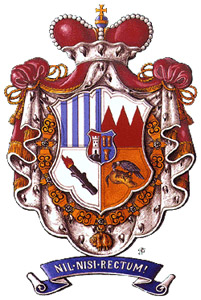
House of Schwarzenberg / Švarcenberkové - Ossuary (Kutná Hora - Sedlec)
N 49° 57.708 E 015° 17.293
33U E 520672 N 5534423
Probably only here, in famous Sedlec Ossuary, you can find so unique coat of arms, made from real human bones only. This really macabre piece of art represents coat of arms of an old Bohemian and Franconian noble family - House of Schwarzenberg.
Waymark Code: WMAQAB
Location: Středočeský kraj, Czechia
Date Posted: 02/12/2011
Views: 114
Probably only here, in famous Sedlec Ossuary, you can find so unique coat of arms, made from real human bones only. This really macabre piece of art represents coat of arms of an old Bohemian and Franconian noble family - House of Schwarzenberg.

The Sedlec Ossuary is a small Gothic chapel, located beneath the Cemetery Church of All Saints in Kutná Hora - Sedlec. The ossuary contains approximately 40000 - 70000 human skeletons which have been artistically arranged to form decorations and furnishings for the chapel. Henry, the abbot of the Cistercian monastery in Sedlec, was sent to the Holy Land by King Otakar II of Bohemia in 1278. When he returned, he brought with him a small amount of earth he had removed from Golgotha and sprinkled it over the abbey cemetery. The word of this pious act soon spread and the cemetery in Sedlec became a desirable burial site throughout Central Europe. During the Black Death in the mid 14th century, and after the Hussite Wars in the early 15th century, many thousands of people were buried there and the cemetery had to be greatly enlarged.
Around 1400 a Gothic chapel was built in the center of the cemetery with a vaulted upper level and a lower chapel to be used as an ossuary for the mass graves unearthed during construction, or simply slated for abolition to make room for new burials. After 1511 the task of exhuming skeletons and stacking their bones in the chapel was, according to legend, given to a half-blind monk of the order. Between 1703-1710 a new entrance was constructed to support the front wall, which was leaning outward, and the upper chapel was rebuilt. This work, in the Czech Gothic-Baroque style, was designed by famous Jan Blažej Santini-Aichel.
In 1870, František Rint, a woodcarver, was employed by the Schwarzenberg family to put the bone heaps into order. The macabre result of his effort speaks for itself. Four enormous bell-shaped mounds occupy the corners of the chapel. An enormous chandelier of bones, which contains at least one of every bone in the human body, hangs from the center of the nave with garlands of skulls draping the vaults. Other works include piers and monstrances flanking the altar, a large Schwarzenberg coat-of-arms, and the signature of Master Rint, also executed in bone, on the wall near the entrance.
Schwarzenberg (Czech: ze Švarcenberka) is the name of a Franconian and Bohemian aristocratic family. The family was first mentioned in 1172. A branch of the Seinsheim family was created when Erkinger I of Seinsheim acquired the Franconian barony of Schwarzenberg, the castle Schwarzenberg and the title Baron of Schwarzenberg, in 1405–1421. At this time, they also possessed some fiefdoms in Bohemia. In 1599 the Schwarzenbergs were elevated to Counts and in 1670 to Princes. The House of Schwarzenberg came into extensive land holdings in Bohemia in 1661 through a marriage alliance with the House of Eggenberg. In the 1670s, they established their primary seat in Bohemia. Until 1918 their primary residence was in Ceský Krumlov, Bohemia (now in the Czech Republic). In the late 18th century, the House of Schwarzenberg was divided into two titled lines (majorats). The elder line died out in the male line in 1965 with Heinrich Schwarzenberg, the 11th Prince of Schwarzenberg. The second line was established with Prince Karl Philipp of Schwarzenberg at Orlík, Murau and Vienna. Today the two lines are united under the current head of the house, Prince Karl VII of Schwarzenberg, who serves as the current minister of foreign affairs of the Czech Republic. [wiki]